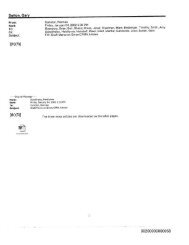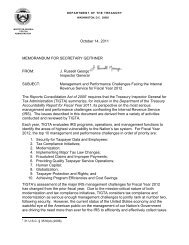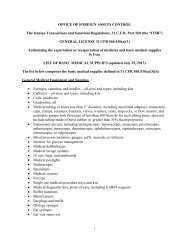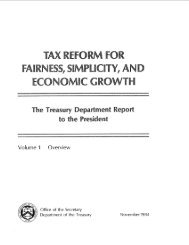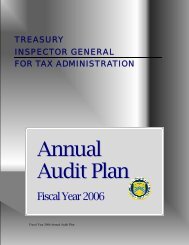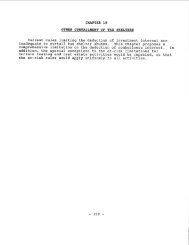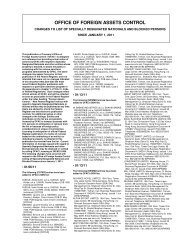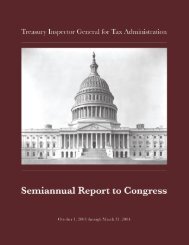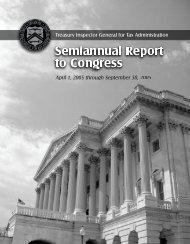Annual Audit Plan -- FY2005 - Department of the Treasury
Annual Audit Plan -- FY2005 - Department of the Treasury
Annual Audit Plan -- FY2005 - Department of the Treasury
Create successful ePaper yourself
Turn your PDF publications into a flip-book with our unique Google optimized e-Paper software.
<strong>Treasury</strong> Inspector General for Tax Administration - Office <strong>of</strong> <strong>Audit</strong><br />
SB/SE taxpayers. For example, <strong>the</strong> IRS must effectively deal with globalization, tax<br />
shelters, <strong>of</strong>fshore tax havens, and industry specialization. Some <strong>of</strong> <strong>the</strong>se issues are<br />
extremely difficult to address. Abusive tax shelters, for instance, are estimated to be a<br />
$10 billion tax issue, and transactions are frequently legally complex and dependent on<br />
exploitation <strong>of</strong> legal loopholes.<br />
The Divisions are endeavoring to revise <strong>the</strong>ir compliance program by reengineering <strong>the</strong><br />
collection and examination practices. Some improvements have been noted. For<br />
example, <strong>the</strong> level <strong>of</strong> compliance activities and <strong>the</strong> results obtained in many Collection<br />
function areas in FY 2003 showed a continuing increase while <strong>the</strong> number <strong>of</strong> Collection<br />
function field staff remained unchanged. The President’s proposed FY 2005 budget<br />
provides for additional Collection function staffing and legislation to allow some cases<br />
to be worked by contract staff. However, if nei<strong>the</strong>r <strong>of</strong> <strong>the</strong>se provisions is approved, a<br />
significant number <strong>of</strong> cases will remain unworked.<br />
The Examination function staffing decreased during FY 2003, however, <strong>the</strong> percent <strong>of</strong><br />
tax returns examined increased, mainly due to increases in correspondence examinations<br />
<strong>of</strong> tax returns for individuals, which are conducted by mailing notices to <strong>the</strong> taxpayer.<br />
While <strong>the</strong>re were increases in <strong>the</strong> number <strong>of</strong> individual examinations overall during<br />
FY 2003, <strong>the</strong>re was a larger increase in <strong>the</strong> coverage rate <strong>of</strong> individuals earning<br />
$100,000 and over than for those under $100,000. In addition, <strong>the</strong>re was a significant<br />
increase in <strong>the</strong> number <strong>of</strong> partnership return examinations. The number <strong>of</strong> corporate tax<br />
return examinations, however, continued <strong>the</strong> decline that started in FY 1997, decreasing<br />
a total <strong>of</strong> 67 percent since that time. The President’s proposed FY 2005 budget provides<br />
for additional Examination function staffing. The Commissioner has indicated that<br />
some <strong>of</strong> <strong>the</strong> increase would be allocated to corporate compliance.<br />
The SB/SE Division initiated an in-depth review <strong>of</strong> <strong>the</strong> examination process to<br />
reengineer and/or redesign processes, products, and services. A TIGTA audit 13 <strong>of</strong> one<br />
reengineering project – <strong>the</strong> Field Examination Reengineering Pilot – showed that many<br />
aspects <strong>of</strong> <strong>the</strong> Pilot were effectively implemented. The Project Team provided effective<br />
oversight <strong>of</strong> <strong>the</strong> Pilot implementation and ensured <strong>the</strong> new process was being followed<br />
and working as intended. The reengineered process provided enhanced uniformity in<br />
workpaper documentation. Also, concurrence 14 and engagement 15 meetings were<br />
designed to promote greater collaboration and cooperation among group managers,<br />
revenue agents, and taxpayers. However, results from <strong>the</strong> Pilot showed that three <strong>of</strong> <strong>the</strong><br />
five goals established for <strong>the</strong> Pilot were ei<strong>the</strong>r not met or not fully measured. The Pilot<br />
cases did not result in decreased cycle time per case, and <strong>the</strong>re was no quantitative<br />
analysis to determine whe<strong>the</strong>r employee and customer satisfaction measures were<br />
maintained or increased in comparison with using <strong>the</strong> old Field Examination function<br />
13 Many Aspects <strong>of</strong> <strong>the</strong> Field Examination Reengineering Pilot Were Effectively Implemented; However,<br />
Continued Monitoring Is Needed During <strong>the</strong> Nationwide Rollout (Reference Number 2004-30-116, dated<br />
June 30, 2004).<br />
14 Group Managers hold concurrence meetings with revenue agents for each case to promote collaboration<br />
and provide assurance that revenue agents properly planned for examining issues selected for verification.<br />
15 Revenue agents hold engagement meetings with taxpayers or <strong>the</strong>ir representatives to provide a clear<br />
understanding <strong>of</strong> <strong>the</strong> actions, information, and expectations related to an examination.<br />
Fiscal Year 2005 <strong>Annual</strong> <strong>Audit</strong> <strong>Plan</strong> Page 14



